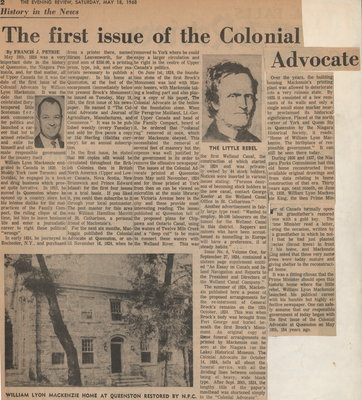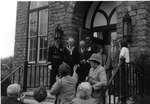May 18th, 1824 was a very important date in the history of Queenston, the Niagara Peninsula, and, for that matter, all of Upper Canada for it was the date of the first issue of the Colonial Advocate by William Lyon Mackenzie. It was the date that this celebrated fiery-tempered little Scotsman forsook commerce for politics and launched a career that led to armed rebellion and exile for himself and ultimate responsible government for the country itself.
William Lyon Mackenzie emigrated to Canada in 1820. In Muddy York (now Toronto) and Dundas, he engaged in a book and drug business which proved quite lucrative. In 1823, he moved to Queenston where he opened up a country store but his intense dislike for the malpractices of the Family Compact, the ruling clique of the time, led him to leave business life and enter a journalistic career to right these political "wrongs".
In early 1824, he journeyed to Rochester, N.Y., and purchased from a printer there, named Hiram Leavenworth, for the grand sum of $350.00, a printing press, type, ink, and other materials necessary to publish a newspaper. In his home at Queenston, at the foot of the escarpment (immediately below the present Brock's Monument) he issued on Tuesday, May 18, 1824, the first issue of his newspaper. He named it "The Colonial Advocate and Journal of Agriculture, Manufactures, and Commerce." It was to be published weekly (every Tuesday) and sold for five pence a copy or 15£ Sterling (Halifax currency) for an annual subscription.
In the first issue, he stated that 900 copies of it would be circulated throughout the British Colonies then in British North America (Upper and Lower Canada, Nova Scotia, New Brunswick and Prince Edward Island) for the first four issues on a trial basis. If you liked it, you could then subscribe to it through your local postmaster. The post master for this area was William Hamilton Merritt of St. Catharines, a personal friend of Mackenzie's.
For the next six months, Mackenzie published the Colonial Advocate at Queenston, or until November 18, 1824, when he removed to York where he could enjoy a larger circulation and be right in the centre of Upper Canada's politics.
On June 1st, 1824, the foundation stone of the first Brock's Monument was laid with Masonic honors, with Mackenzie taking a leading part and also placing a copy of his paper, The Colonial Advocate in the hollow of the foundation stone. When Sir Peregrine Maitland, Lt.-Gov. of Upper Canada and head of the Family Compact, heard of it, he ordered that "colonial rag" removed at once, which order Mackenzie obeyed. This necessitated the removal of several feet of masonry but the expense was well justified by the government in its order to remove the offensive newspaper.
The issues of the Colonial Advocate printed at Queenston from May until November, 1824 and for those printed at York from then on can be viewed on microfilm at the main library on Victoria Avenue here in the city and these provide most interesting reading. The issues published at Queenston tell of the proposed plans for Chippawa and Ontario Canal, using the waters of Twelve Mile Creek and a "deep cut" to be made to connect these waters with the Welland River. This was the first Welland Canal, the construction of which started in 1824 and was privately owned by 44 stock holders. Notices were inserted in various! issues stating: "Persons desirous of becoming stock holders in the new canal, contact George Keefer at the Welland Canal Office in St. Catharines."
Another advertisement in fairly large type read: "Wanted to employ, 50-100 labourers on the tunnel for the Welland Canal in this district. Sappers and miners who have been accustomed to tunnelling in Europe will have a preference, if of steady habits." . . .
Issue No. 6, Volume One, for September 27, 1824, contained a sixteen page supplement entitled "An Essay on Canals and Inland Navigation and Reports to the President and Directors of the Welland Canal Company."
The summer of 1824, Mackenzie published here a poster of the proposed arrangements for the re-interment of General Brock's remains on the 13th October, 1824. This was when Brock's body was brought from Fort George and buried beneath the first Brock's Monument. An original copy of these funeral arrangements as printed by Mackenzie can be seen at the Niagara on the Lake Historical Museum. The Colonial Advocate for October 14, 1824, tells all about the funeral service, with all the dividing lines between columns being of heavy, wide black type. After Sept. 30th, 1824, the lengthy title of the paper's masthead was shortened simply to the "Colonial Advocate".
Over the years, the building housing Mackenzie's printing plant was allowed to deteriorate into a very ruinous state. By 1935 it consisted of a few remnants of its walls and only a single small stone marker nearby proclaimed its historical significance. Placed at the north
corner of York and Queen Sts in Queenston by the Niagara Historical Society, it reads: "Home of William Lyon Mackenzie. The birthplace of responsible government." It can still be seen there today.
During 1936 and 1937, the Niagara Parks Commission had this old home reconstructed from available original drawings and from data relating to home construction of that era. Thirty years ago, next month, on June 18, 1938, William Lyon Mackenzie King, the then Prime Minister of Canada formally opened his grandfather's restored home with a gold key. The Prime Minister read a letter, written by s grandfather in which he noted that he had just planted acacias (locust trees) in front of his home, and Mackenzie King noted that these very same trees were today mature and giving shelter to the reconstructed home.
It was a fitting climax that the Prime Minister should open this historic home where the little rebel, William Lyon Mackenzie launched his political career with his humble but highly effective newspaper. One can safely assume that our responsible government of today began with the first issue of the Colonial Advocate at Queenston on May 18th, 154 years ago.




